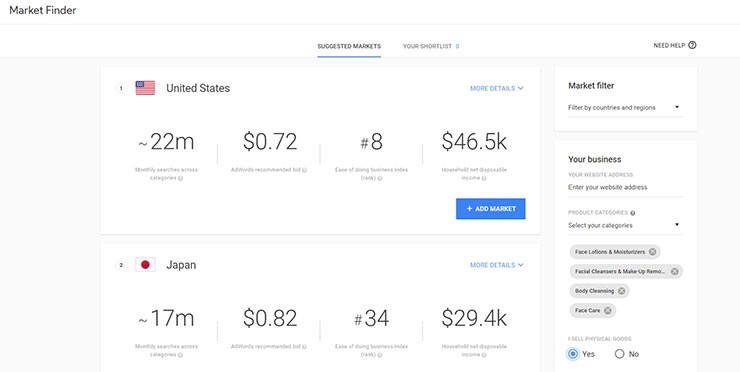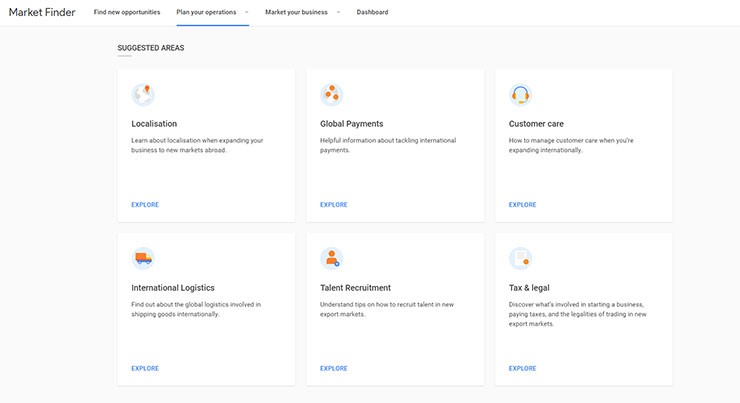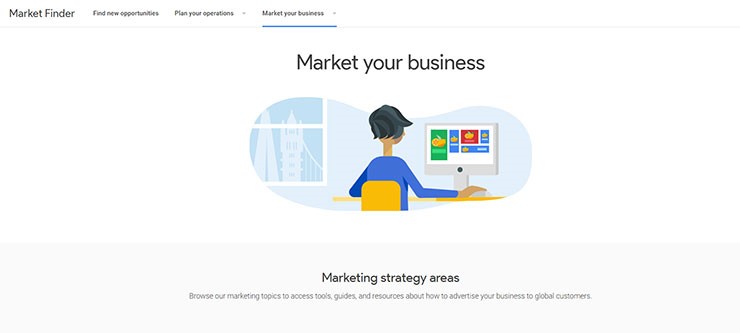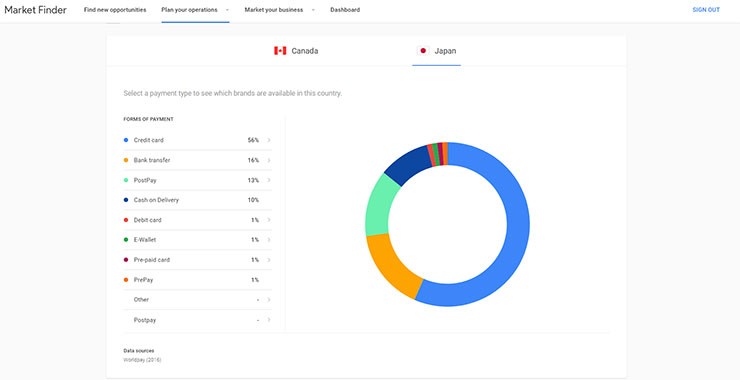
![]() Insights
Insights
International
One of the many challenges companies face when expanding internationally is choosing which market will provide them with the best return for their service or product.
Whilst a company may have intrinsic knowledge of its domestic market, new territories present a challenge with different language and localisation requirements. To help SMEs with this challenge, Google has developed a platform called Market Finder.
Google Market Finder hosts a hub of information to help companies understand the requirements of new markets, to decide which one is right for them. But is it enough to secure international success on its own?
We take a look at how Market Finder can help companies expand internationally and discuss what else needs to be considered to stand the best chance of global success.
Market Finder is a free platform provided by Google, which aims to help companies identify new markets and grow internationally. The platform is separated into three sections, which each provide insights and advice for expanding globally.

One of the core purposes of the platform is to help companies find the best markets to enter based on their product or service. By entering the URL of your domestic website, the tool automatically pulls the categories of the products you sell or services you offer. You can amend these categories or add more up to a maximum of five.
Market Finder will then recommend a list of potential markets for your business to expand into. These suggestions are based on a number of factors, including monthly search volumes, Google Ads cost-per-click and household disposable income.
If you are logged in, you can discover more in-depth country information, such as purchase behaviour and the languages spoken, before shortlisting up to three countries.

Once you’ve shortlisted your potential new markets, you can use the available guides and resources to look at the operational elements you need to consider. Google has created videos, articles and guides on topics such as localisation, international payments and logistics.

The last section of Google Market Finder focuses on how to market your business in new countries. The resources in this part cover topics such as search advertising, display advertising and global marketing strategy.
It also links to Google tools that will help you put your campaigns into practice, such as Google Keyword Planner.
Google Market Finder will inevitably improve companies’ understanding of different markets and help to guide decisions on which markets to enter. It also helps to change the perception that going international only involves translating the content on your website into another language.
However, there are still certain limitations to be aware of, to ensure you make the right market entry choice, so you can maximise your ROI.
Google Market Finder allows you to easily see combined keyword volume for five broad categories. Whilst this is useful for a broad comparison of markets and indicates demand along with opportunity size, the results aren’t tailored to your specific company.
The real value of the tool comes from its application with other tools and technology, some of which are linked to Google Market Finder, allowing you to evaluate your data in more detail.
Whilst Google Market Finder saves time in narrowing down opportunities, other tools should be used to validate the keyword volumes and relate it to your specific product or service. It also doesn’t take into account the technical SEO aspects that should be woven into website translation, allowing you to perform organically in your new market.
For each country, the tool shows the recommended bids, which is calculated using the cost-per-click other advertisers are paying for relevant keywords in the same location. Whilst this can be an indicator of how competitive a market is, it is very general and average bid price will vary depending on the keywords you want to target. It is also a limited view of assessing competition.
The market could be competitively comprised of small companies, but your business is able to compete with a specific niche and target specific, long-tail keywords. Alternatively, the market could be completely monopolised by a competitor whom you may be able to outbid but struggle to compete against in terms of brand awareness. Once again, this offers some great initial insights.
But the benefit of the Google Market Finder can only be truly realised when using it alongside other tools. This lets you see a more accurate cost of PPC in any given market and a more accurate competitive landscape.
Whilst Google Market Finder has a whole host of valuable localisation information, the application of this information is still very much with the user. The tool doesn’t benchmark where you are now, where you need to be or provide a cost of getting you to that point.
For example, Google Market Finder provides you with the payment types that are most used within different markets such as Japan (which is displayed in the screenshot below).
However, it doesn’t analyse which ones you currently have or tell you the costs involved logistically in offering the payment options you don’t currently have.
When it comes to customer service advice, there was no country-specific data displayed for either Canada or Japan, making it difficult to action the advice without further research and expertise.

When entering any market, it is important to consider the impact offering the right payments options will have on your overall costs, and time needed to implement the changes. This is something Google Market Finder helps you look towards, but doesn’t solve.
Whilst Market Finder is a great source of information on various factors to be considered, it is just that – information. The platform doesn’t provide a quick fix that can translate your website, localise your content or enable your message to instantly resonate with local buyers.
All the information needs to be digested, understood and applied. Then implementation can be managed internally or with the support of external vendors.
There are huge benefits for understanding more about the market you are entering. But essentially, project managing all aspects in-house, in particular localisation and digital marketing, can become a huge and complicated task.
Google Market Finder provides a wealth of valuable information and data for companies, allowing them to make more insightful decisions about which markets are best for them to enter.
However, the full potential of the platform can only be utilised when the data and insights are used alongside other tools with guidance from experts.
We encourage all businesses looking to expand internationally to thoroughly explore the platform, to better understand the opportunities that are available and the true cost of expansion for them.
Interested in taking your business global?Learn how by downloading our whitepaper

![]() Insights
Insights

![]() Insights
Insights

![]() Insights
Insights